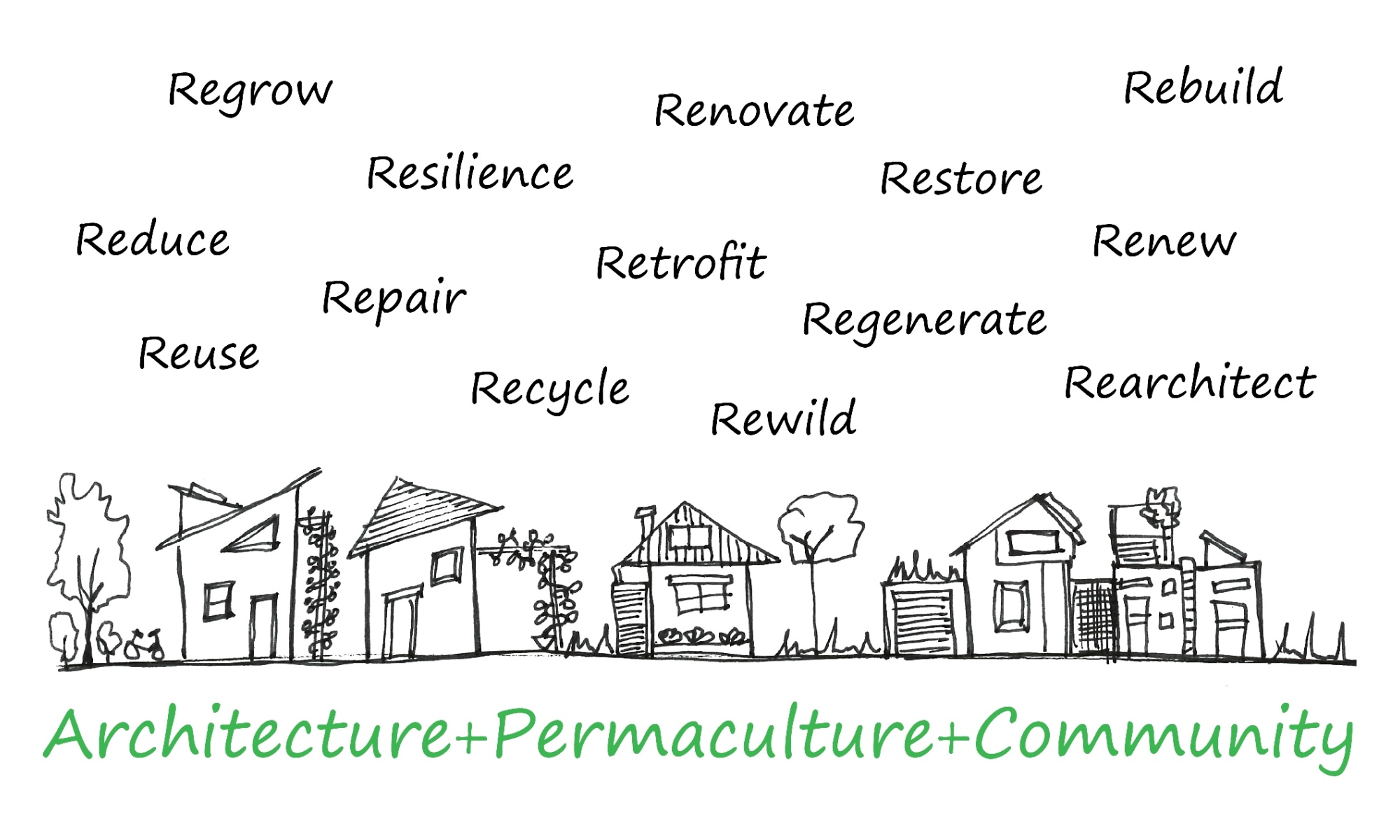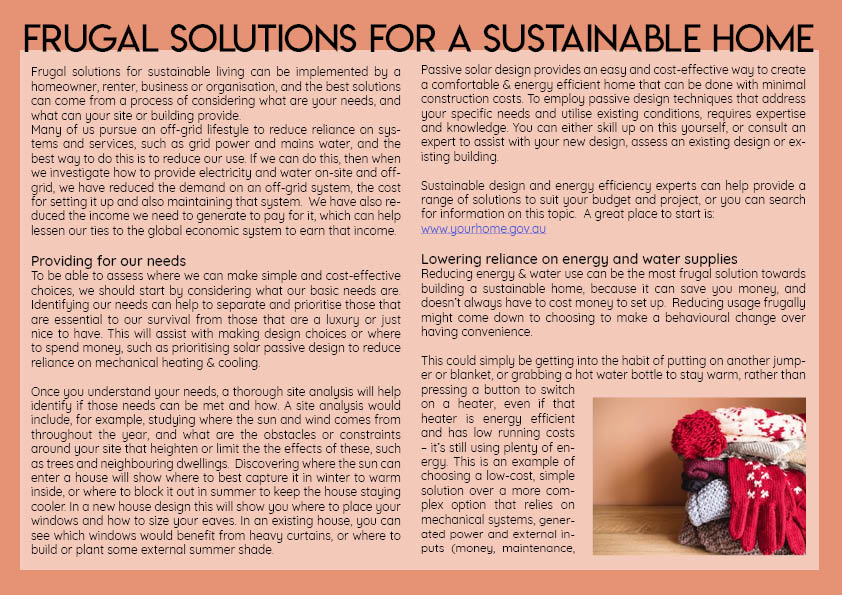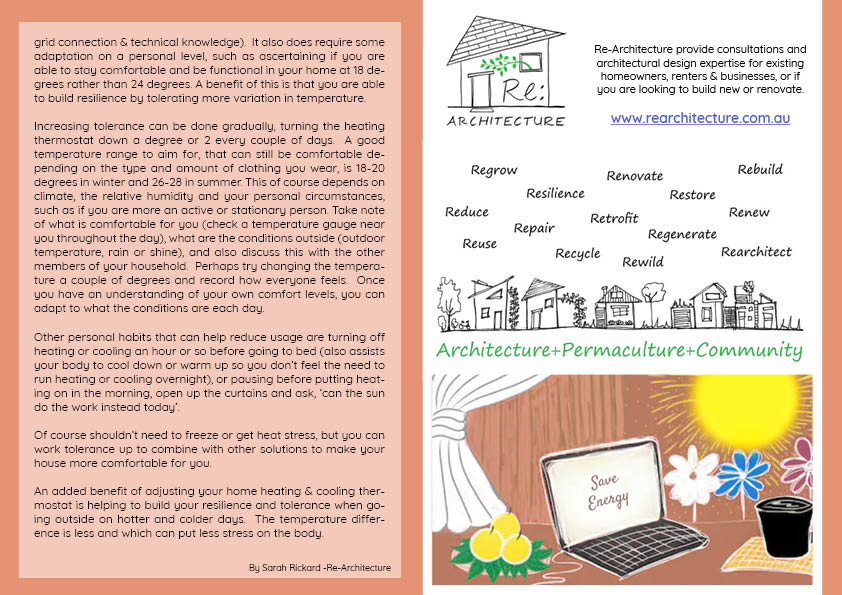Re-Architecture are delighted to be able contribute this article for an online magazine that has been created in place of this year’s Off-grid Living Festival (postponed to 2021, and we will be there!)
You can read the article (scroll past the images) or to download the whole magazine click on the “OFF-GRID LIVING MAGAZINE” ad to go to the festival site.
Frugal solutions for sustainable living can be implemented by a homeowner, renter, business or organisation, and the best solutions can come from a process of considering what are your needs, and what can your site or building provide.
Many of us pursue an off-grid lifestyle to reduce reliance on systems and services, such as grid power and mains water, and the best way to do this is to reduce our use. If we can do this, then when we investigate how to provide electricity and water on-site and off-grid, we have reduced the demand on an off-grid system, the cost for setting it up and also maintaining that system. We have also reduced the income we need to generate to pay for it, which can help lessen our ties to the global economic system to earn that income.
Providing for our needs
To be able to assess where we can make simple and cost-effective choices, we should start by considering what our basic needs are. Identifying our needs can help to separate and prioritise those that are essential to our survival from those that are a luxury or just nice to have. This will assist with making design choices or where to spend money, such as prioritising solar passive design to reduce reliance on mechanical heating & cooling.
Once you understand your needs, a thorough site analysis will help identify if those needs can be met and how. A site analysis would include, for example, studying where the sun and wind comes from throughout the year, and what are the obstacles or constraints around your site that heighten or limit the the effects of these, such as trees and neighbouring dwellings. Discovering where the sun can enter a house will show where to best capture it in winter to warm inside, or where to block it out in summer to keep the house staying cooler. In a new house design this will show you where to place your windows and how to size your eaves. In an existing house, you can see which windows would benefit from heavy curtains, or where to build or plant some external summer shade.
Passive solar design provides an easy and cost-effective way to create a comfortable & energy efficient home that can be done with minimal construction costs. To employ passive design techniques that address your specific needs and utilise existing conditions, requires expertise and knowledge. You can either skill up on this yourself, or consult an expert to assist with your new design, assess an existing design or existing building.
Sustainable design and energy efficiency experts can help provide a range of solutions to suit your budget and project, or you can search for information on this topic. A great place to start is: www.yourhome.gov.au
Lowering reliance on energy and water supplies
Reducing energy & water use can be the most frugal solution towards building a sustainable home, because it can save you money, and doesn’t always have to cost money to set up. Reducing usage frugally might come down to choosing to make a behavioural change over having convenience.
This could simply be getting into the habit of putting on a jumper to stay warm rather than pressing a button to switch on a heater, even if that heater is energy efficient and has low running costs. This is an example of choosing a low-cost, simple solution over a more complex option that relies on mechanical systems, generated power and external inputs (money, maintenance, grid connection & technical knowledge). It also does require some adaptation on a personal level, such as ascertaining if you are able to stay comfortable and be functional in your home at 18 degrees rather than 24 degrees. A benefit of this is that you are able to build resilience by tolerating more variation in temperature.
Increasing tolerance can be done gradually, turning the heating thermostat down a degree or 2 every couple of days. A good temperature range to aim for, that can still be comfortable depending on the type and amount of clothing you wear, is 18-20 degrees in winter and 26-28 in summer. This of course depends on climate, the relative humidity and your personal circumstances, such as if you are more an active or stationary person. Take note of what is comfortable for you (check a temperature gauge near you throughout the day), what are the conditions outside (outdoor temperature, rain or shine), and also discuss this with the other members of your household. Perhaps try changing the temperature a couple of degrees and record how everyone feels. Once you have an understanding of your own comfort levels, you can adapt to what the conditions are each day.
Other personal habits that can help reduce usage are turning off heating or cooling an hour or so before going to bed (also assists your body to cool down or warm up so you don’t feel the need to run heating or cooling overnight), or pausing before putting heating on in the morning, open up the curtains and ask, ‘can the sun do the work instead today’.
Of course shouldn’t need to freeze or get heat stress, but you can work tolerance up to combine with other solutions to make your house more comfortable for you.
An added benefit of adjusting your home heating & cooling thermostat is helping to build your resilience a tolerance when going outside on hotter and colder days. The temperature difference is less and which can put less stress on the body.



